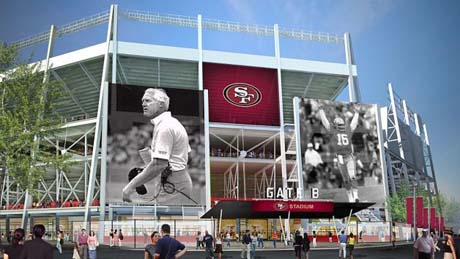Here it comes. The biggest, baddest sports spectacular in the United States of America. Super Bowl L—that is L as in roman numeral 50; and “L” as in “L”ove it—will be an unofficial national holiday. This is an extravaganza and event so special that it dwarfs all other sporting events.
It started with a vision, a letter and a personal visit. Former Santa Clara Vice Mayor Kevin Moore, a sports enthusiast, wrote a letter to the San Francisco 49ers describing his idea to build a new stadium in Santa Clara. It was a Hail Mary, but the 49ers were already headquartered in Santa Clara, the land was available, the weather is outstanding, the infrastructure and transit options first class, and Candlestick Park was a deteriorating joke.
Moore hand delivered his idea to the 49ers’ headquarters. The missive was taken upstairs to Larry MacNeil, who is currently the team’s executive director of development. Thus began the odyssey that will culminate in a new 49ers stadium in Santa Clara.
Soon after, meetings with John York, who played a pivotal role in the effort, became initial negotiations with the city of Santa Clara. City manager Jennifer Sparacino was initially skeptical of the plan. When the younger, charismatic Jed York took the reigns, the project picked up momentum. Jed York is not pretentious. Rather, he is an optimistic figure who understands 49ers history, and he was willing to go to people’s houses individually to garner support.
During this time, Moore became the go-to-guy in helping communicate policy and political support for the project; often using shuttle diplomacy between the 49ers executives and his city’s administration, careful not to overstep his role.
Moore next came up with the idea to take Commissioner Roger Goodell and top NFL executives up on the sky tower ride at California’s Great America Amusement Park. He enlisted Mayor Patricia Mahan to guide the tour, and Mahan extolled the virtues of Santa Clara, including the existing infrastructure and transportation. The day was absolute magic!
Moore, Mahan and Councilmember Lisa Gillmor became the trinity of the stadium project, acting in unison to provide the political validation necessary for success.
Moore is a very competitive person. He is not above playing hard ball in a political campaign to win. He has upset a few people in his career, but he is also a person who puts down the gloves after a political fight and will work with anybody who will help improve Santa Clara, or for that matter, the community at large.
He enlisted his other friends on the council, including Jamie Matthews and Pat Kolstad, to build a solid majority for success. They were enthusiastic, natural allies of Moore’s. But Moore also reached out to his past political opponents. Former councilmembers John McLemore and Aldyth Parle became supporters, despite differences from past political campaigns.
Moore’s close allies sometimes gave him grief for reaching out to past political opponents. But he put the interests of the stadium first. He got Chris Stampolis and Jim Rowen, who are currently in the middle of a lawsuit, on board. He made the recommendation to bring on political constituent Ed McGovern, who brilliantly guided the 49ers through the election. He also recommended Jude Barry, Peter Allen and myself to contribute to the victory.
Moore couldn’t convince everybody, but he tried. Two colleagues rebuffed him, but even with their intransigence, he continued to reach out. “How can we bring them aboard?” he would ask. “Is there a win-win deal we can work?”
He steamrolled them politically, only after he realized they would never support the project. In addition, the South Bay Labor Council, Silicon Valley Leadership Group, the Chamber of Commerce crowd, Mercury News and Metro supported the effort.
Once the stadium was a foregone conclusion, the next collaborative effort went forward in a bid for the Super Bowl. Ed Lee, Jamie Mathews, Chuck Reed and Jean Quan checked their mayoral egos at the door and worked together to bring the Super Bowl to the Bay Area. United in their effort, it was a huge juxtaposition from the other contender, Miami, which failed to garner the necessary political support from the state’s legislature.
Now we are getting a Super Bowl in San Francisco, Santa Clara, San Jose and Oakland—the event will lift all of these cities and the entire region. It is a model of what can happen when people come together for the benefit of all.
It is also a testament to one man’s vision, and how he worked behind the scenes to make it a reality. Sometimes the Hail Mary works.
Rich Robinson is a political consultant in Silicon Valley.





Everyone’s rich or going to get rich off of that new statium and Super Bowl 50, but York can’t give more than a measly $500 to the Health Foundation?
Hell they are lucky to get that. If I were York I would start to distant myself from this org.
Sounds like Moore violated the Brown Act by colluding with more than a majority of the council on an issue hat is under the council’s jurisdiction. You perfectly describe how a serial meeting violation of the Brown Act works.
This time it was for good (Go Niners!), but how do we know he doesn’t do this on all issues, coordinating votes out of the public’s eye?
Mayor Reed’s charisma and negotiating savvy were no doubt the pivotal point in bringing the Superbowl to Santa Clara.
Sweet now the world can see for them selves what Reed has done to San Jose !